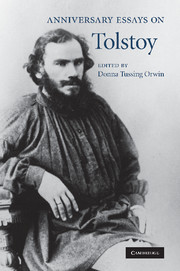Book contents
- Frontmatter
- Contents
- Acknowledgments
- List of contributors
- Introduction
- 1 Tolstoy and music
- 2 Sublime vision and self-derision: the aesthetics of death in Tolstoy
- 3 Tolstoy's peaceable kingdom
- 4 Leo Tolstoy: pacifist, patriot, and molodets
- 5 Leo Tolstoy's correspondence with Nikolai Strakhov: the dialogue on faith
- 6 The worm of doubt: Prince Andrei's death and Russian spiritual awakening of the 1860s
- 7 Tolstoy's spirituality
- 8 Tracking the English novel in Anna Karenina: who wrote the English novel that Anna reads?
- 9 Violence and the role of drama in the late Tolstoy: The Realm of Darkness
- 10 What men quote by: Tolstoy, wise sayings, and moral tales
- 11 The “proletarian lord”: Leo Tolstoy's image during the Russian revolutionary period
- Bibliography
- Index
9 - Violence and the role of drama in the late Tolstoy: The Realm of Darkness
Published online by Cambridge University Press: 03 May 2010
- Frontmatter
- Contents
- Acknowledgments
- List of contributors
- Introduction
- 1 Tolstoy and music
- 2 Sublime vision and self-derision: the aesthetics of death in Tolstoy
- 3 Tolstoy's peaceable kingdom
- 4 Leo Tolstoy: pacifist, patriot, and molodets
- 5 Leo Tolstoy's correspondence with Nikolai Strakhov: the dialogue on faith
- 6 The worm of doubt: Prince Andrei's death and Russian spiritual awakening of the 1860s
- 7 Tolstoy's spirituality
- 8 Tracking the English novel in Anna Karenina: who wrote the English novel that Anna reads?
- 9 Violence and the role of drama in the late Tolstoy: The Realm of Darkness
- 10 What men quote by: Tolstoy, wise sayings, and moral tales
- 11 The “proletarian lord”: Leo Tolstoy's image during the Russian revolutionary period
- Bibliography
- Index
Summary
NIKITA […] My dear Pa, you also forgive me, a sinner! Yuh told me at the beginnin' when I started this whorin' nasty life, yuh told me: “If a claw gets stuck, the bird is lost.” I didn't listen t'yer words, no good dog that I am, an' it turned out like yuh said. Forgive me, for God's sake. (90; PSS 26: 242)
The Realm of Darkness: If a Claw Gets Stuck, the Bird is LostTolstoy's plays have gone relatively unstudied by scholars. Unlike his fiction, his plays do not so thoroughly engage in psychological analysis and introspection. In cases of sinful, violent behavior, however, sometimes reason and rationalization cannot explain why a character acts the way he or she does, and thus the stage is an ideal forum for conveying an aesthetic and moral idea. The preeminent example, and one of Tolstoy's most successful plays, is The Realm of Darkness: If a Claw Gets Stuck, the Bird is Lost (1886). The purpose of this chapter is to illuminate the aesthetic context for Tolstoy's depiction of violence in The Realm of Darkness, a work that exemplifies many of the artistic goals Tolstoy had for his fiction in the latter part of his career.
Three critical points of view may be assumed for viewing the less significant work of a major author, in this case the plays of Tolstoy.
- Type
- Chapter
- Information
- Anniversary Essays on Tolstoy , pp. 183 - 198Publisher: Cambridge University PressPrint publication year: 2010



